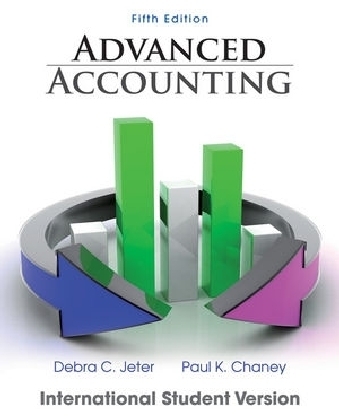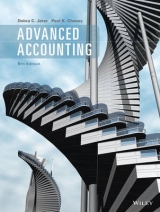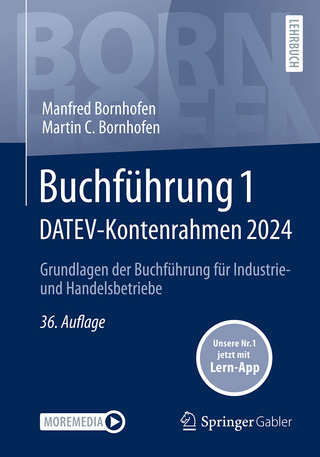
Advanced Accounting
John Wiley & Sons Inc (Verlag)
978-1-118-09861-5 (ISBN)
- Titel erscheint in neuer Auflage
- Artikel merken
Building upon previous editions of Advanced Accounting, author Debra C. Jeter continues to deliver a balanced and detailed approach to the conceptual and technical aspects of advanced accounting. This new and enhanced edition features more in-depth information about international accounting, the upcoming globalization of accounting standards, changes with FASB's, and the latest developments and differences between U.S. GAAP and IFRS. As always, the text also includes comprehensive coverage of all three methods of consolidated financial reporting (cost, partial equity, complete equity).
1 INTRODUCTION TO BUSINESS COMBINATIONS AND THE CONCEPTUAL FRAMEWORK 1 Learning Objectives 1 Planning M&A in a Changing Environment and Under Changing Accounting Requirements 4 Nature of the Combination 5 Business Combinations: Why? Why Not? 7 Business Combinations: Historical Perspective 10 Terminology and Types of Combinations 14 Takeover Premiums 17 Avoiding the Pitfalls before the Deal 18 Determining Price and Method of Payment in Business Combinations 20 Alternative Concepts of Consolidated Financial Statements 25 FASB s Conceptual Framework 29 FASB Codification (Source of GAAP) 36 Summary 41 Appendix: Evaluating Firm Performance 42 Questions 49 Analyzing Financial Statements 49 Exercises 51 ASC (Accounting Standards Codification) Exercises 53 2 ACCOUNTING FOR BUSINESS COMBINATIONS 54 Learning Objectives 54 Historical Perspective on Business Combinations 54 Pro Forma Statements and Disclosure Requirement 63 Explanation and Illustration of Acquisition Accounting 65 Contingent Consideration in an Acquisition 70 Leveraged Buyouts 75 IFRS versus U.S. GAAP 76 Summary 77 Appendix A: Deferred Taxes in Business Combinations 79 Questions 81 Analyzing Financial Statements 82 Exercises 84 ASC Exercises 90 Problems 91 3 CONSOLIDATED FINANCIAL STATEMENTS DATE OF ACQUISITION 96 Learning Objectives 96 Definitions of Subsidiary and Control 98 Requirements for the Inclusion of Subsidiaries in the Consolidated Financial Statements 102 Reasons for Subsidiary Companies 103 Consolidated Financial Statements 103 Investments at the Date of Acquisition 105 Consolidated Balance Sheets: The Use of Workpapers 106 A Comprehensive Illustration More than One Subsidiary Company 123 Limitations of Consolidated Statements 125 Summary 128 Appendix A: Deferred Taxes on the Date of Acquisition 129 Accounting for Uncertain Tax Positions 130 Appendix B: Consolidation of Variable Interest Entities 132 Questions 134 Analyzing Financial Statements 135 Exercises 136 ASC Exercises 141 Problems 142 4 CONSOLIDATED FINANCIAL STATEMENTS AFTER ACQUISITION 149 Learning Objectives 149 Accounting for Investments by the Cost, Partial Equity, and Complete Equity Methods 150 Consolidated Statements after Acquisition Cost Method 158 Recording Investments in Subsidiaries Equity Method (Partial or Complete) 170 Elimination of Intercompany Revenue and Expense Items 180 Interim Acquisitions of Subsidiary Stock 182 Consolidated Statement of Cash Flows 194 Illustration of Preparation of a Consolidated Statement of Cash Flows Year of Acquisition 197 Compare U.S. GAAP and IFRS Regarding Equity Method 201 Summary 202 Appendix A: Alternative Workpaper Format 203 Appendix B: Deferred Tax Consequences When Affiliates File Separate Income Tax Returns Undistributed Income 205 Consolidated Tax Returns Affiliated Companies (80% or More Ownership Levels) 206 Separate Tax Returns Deferred Tax Consequences Arising Because of Undistributed Subsidiary Income 206 The Cost Method Separate Tax Returns 207 Undistributed Income Is Expected to Be Realized When the Subsidiary Is Sold 209 The Partial and Complete Equity Methods Separate Tax Returns 209 Questions 211 Analyzing Financial Statements 212 Exercises 214 ASC Exercises 220 Problems 221 5 ALLOCATION AND DEPRECIATION OF DIFFERENCES BETWEEN IMPLIED AND BOOK VALUES 234 Learning Objectives 234 Allocation of the Difference Between Implied and Book Values to Assets and Liabilities of Subsidiary Acquisition Date 236 Effect of Allocation and Depreciation of Differences Between Implied and Book Values on Consolidated Net Income Year Subsequent to Acquisition 243 Consolidated Statements Workpaper Investment Recorded Using the Cost Method 248 Cost Method Analysis of Controlling and Noncontrolling Interests in Consolidated Net Income and Retained Earnings 257 Consolidated Statements Workpaper Investment Recorded Using Partial Equity Method 259 Partial Equity Method Analysis of Controlling and Noncontrolling Interests in Consolidated Net Income and Retained Earnings 267 Consolidated Statements Workpaper Investment Recorded Using Complete Equity Method 269 Complete Equity Method Analysis of Controlling Interest in Consolidated Net Income and Retained Earnings 277 Additional Considerations Relating to Treatment of Difference Between Implied and Book Values 278 Push Down Accounting 287 IFRS vs. U.S. GAAP on Research & Development Costs 292 Summary 293 Questions 294 Analyzing Financial Statements 296 Exercises 297 ASC Exercises 303 Problems 303 6 ELIMINATION OF UNREALIZED PROFIT ON INTERCOMPANY SALES OF INVENTORY 320 Learning Objectives 320 Effects of Intercompany Sales of Merchandise on the Determination of Consolidated Balances 321 Cost Method: Consolidated Statements Workpaper Upstream Sales 331 Cost Method Analysis of Consolidated Net Income and Consolidated Retained Earnings 337 Consolidated Statements Workpaper Partial Equity Method 340 Partial Equity Method Analysis of Consolidated Net Income and Consolidated Retained Earnings 344 Consolidated Statements Workpaper Complete Equity Method 345 Complete Equity Method Analysis of Consolidated Net Income and Consolidated Retained Earnings 350 Summary of Workpaper Entries Relating to Intercompany Sales of Inventory 350 Intercompany Profit Prior to Parent Subsidiary Affiliation 351 Summary 352 Appendix: Deferred Taxes and Intercompany Sales of Inventory 353 Deferred Tax Consequences Arising Because of Unrealized Intercompany Profit 353 Intercompany Sales of Inventory Cost and Partial Equity Method 354 Undistributed Subsidiary Income Impact of Unrealized Intercompany Profit on the Calculation of Deferred Taxes 356 Questions 359 Analyzing Financial Statements 360 Exercises 362 ASC Exercises 365 Problems 365 7 ELIMINATION OF UNREALIZED GAINS OR LOSSES ON INTERCOMPANY SALES OF PROPERTY AND EQUIPMENT 380 Learning Objectives 380 Intercompany Sales of Land (Nondepreciable Property) 381 Intercompany Sales of Depreciable Property (Machinery, Equipment, and Buildings) 384 Consolidated Statements Workpaper Cost and Partial Equity Methods 392 Calculation of Consolidated Net Income and Consolidated Retained Earnings 401 Consolidated Statements Workpaper Complete Equity Method 405 Calculation and Allocation of Consolidated Net Income; Consolidated Retained Earnings: Complete Equity Method 411 Summary of Workpaper Entries Relating to Intercompany Sales of Equipment 411 Intercompany Interest, Rents, and Service Fees 411 Summary 415 Appendix: Deferred Tax Consequences Related to Intercompany Sales of Equipment 416 Impact of Unrealized Intercompany Profit on the Calculation of Deferred Tax Consequences Related to Undistributed Subsidiary Income 418 Calculations (and Allocation) of Consolidated Net Income and Consolidated Retained Earnings 419 Questions 421 Analyzing Financial Statements 421 Exercises 422 ASC Exercises 425 Problems 425 8 CHANGES IN OWNERSHIP INTEREST 437 Learning Objectives 437 Parent Acquires Subsidiary Stock Through Several Open-Market Purchases Cost Method 439 Parent Sells Subsidiary Stock Investment on the Open Market Cost Method 443 Equity Method Purchases and Sales of Subsidiary Stock by the Parent 447 Parent Sells Subsidiary Stock Investment on the Open Market Cost Method 451 Subsidiary Issues Stock 453 Summary 463 Questions 464 Analyzing Financial Statements 464 Exercises 465 ASC Exercises 468 Problems 468 9 INTERCOMPANY BOND HOLDINGS AND MISCELLANEOUS TOPICS CONSOLIDATED FINANCIAL STATEMENTS 477 Learning Objectives 477 Intercompany Bond Holdings 478 Accounting for Bonds A Review 479 Constructive Gain or Loss on Intercompany Bond Holdings 480 Accounting for Intercompany Bonds Illustrated 483 Book Entry Related to Bond Investment 484 Interim Purchase of Intercompany Bonds 500 Notes Receivable Discounted 501 Stock Dividends Issued by a Subsidiary Company 503 Dividends from Preacquisition Earnings 507 Subsidiary with Both Preferred and Common Stock Outstanding 508 Consolidating a Subsidiary with Preferred Stock Outstanding 511 Summary 522 Questions 523 Analyzing Financial Statements 524 Exercises 526 ASC Exercises 530 Problems 530 10 INSOLVENCY LIQUIDATION AND REORGANIZATION 542 Learning Objectives 542 Contractual Agreements 543 Bankruptcy 545 Liquidation (Chapter 7) 550 Reorganization Under the Reform Act (Chapter 11) 551 Trustee Accounting and Reporting 562 Realization and Liquidation Account 565 Summary 571 Questions 572 Analyzing Financial Statements 572 Exercises 577 ASC Exercises 581 Problems 581 11 INTERNATIONAL FINANCIAL REPORTING STANDARDS 588 Learning Objectives 588 The Increasing Importance of International Accounting Standards 588 The Road to Convergence U.S. GAAP and IFRS 589 Significant Similarities and Differences Between U.S. GAAP and IFRS 594 GAAP Hierarchy U.S. versus IFRS 595 Long-Term Convergence Issues FASB and IASB 605 Lease Accounting Convergence 605 Revenue Recognition Convergence 607 Financial Statement Presentation 609 Potential Changes to Financial Statements 610 International Convergence Issues 614 American Depository Receipts: An Overview 617 Summary 620 Appendix A: List of Current International Financial Reporting Standards, Issued by IASC and IASB 621 Questions 622 Analyzing Financial Statements 623 Exercises 625 ASC Exercises 627 Problems 627 12 ACCOUNTING FOR FOREIGN CURRENCY TRANSACTIONS AND HEDGING FOREIGN EXCHANGE RISK 631 Learning Objectives 631 Exchange Rates Means of Translation 632 Measured versus Denominated 635 Foreign Currency Transactions 635 Using Forward Contracts as a Hedge 645 Summary 664 Questions 665 Analyzing Financial Statements 666 Exercises 666 ASC Exercises 674 Problems 674 13 TRANSLATION OF FINANCIAL STATEMENTS OF FOREIGN AFFILIATES 682 Learning Objectives 682 Accounting for Operations in Foreign Countries 683 Translating Financial Statements of Foreign Affiliates 684 Objectives of Translation SFAS No. 52 [ASC 830 30] 685 Translation Methods 686 Identifying the Functional Currency 687 Translation of Foreign Currency Financial Statements 689 Translation of Foreign Financial Statements Illustrated 693 Financial Statement Disclosure 702 Historical Developments of Accounting Standards 704 Summary 706 Appendix: Accounting for a Foreign Affiliate and Preparation of Consolidated Statements Workpaper Illustrated 707 Date of Acquisition 707 Accounting for an Investment in a Foreign Affiliate After Acquisition 708 Consolidation When the Temporal Method of Translation Is Used 709 Remeasurement and Translation of Foreign Currency Transactions 711 Intercompany Receivables and Payables 712 Elimination of Intercompany Profit 712 Liquidation of a Foreign Investment 713 Questions 714 Analyzing Financial Statements 714 Exercises 716 ASC Exercises 723 Problems 723 14 REPORTING FOR SEGMENTS AND FOR INTERIM FINANCIAL PERIODS 733 Learning Objectives 733 Need for Disaggregated Financial Data 734 Standards of Financial Accounting and Reporting 734 International Accounting Standards Board (IASB) Position On Segment Reporting 746 Interim Financial Reporting 747 Summary 756 Appendix: GE Segmental Disclosures, 2010 Annual Report (partial) 758 Basic for Presentation 760 Questions 761 Exercises 764 ASC Exercises 768 Problems 768 15 PARTNERSHIPS: FORMATION, OPERATION, AND OWNERSHIP CHANGES 773 Learning Objectives 773 Partnership Defined 774 Reasons for Forming a Partnership 776 Characteristics of a Partnership 776 Partnership Agreement 779 Accounting for a Partnership 780 Special Problems in Allocation of Income and Loss 788 Financial Statement Presentation 790 Changes in the Ownership of the Partnership 791 Section A: Admission of a New Partner 793 Section B: Withdrawal of a Partner 800 Summary 804 Questions 805 Exercises 806 ASC Exercises 812 Problems 813 16 PARTNERSHIP LIQUIDATION 820 Learning Objectives 820 Steps in the Liquidation Process 821 Priorities of Partnership and Personal Creditors 823 Simple Liquidation Illustrated 825 Installment Liquidation 827 Incorporation of a Partnership 836 Summary 838 Questions 839 Exercises 839 ASC Exercises 844 Problems 845 Glossary G-1 Appendix ASC: Researching the FASB Codification A-1 Appendix PV: Tables of Present Value A-8 Index I-1
| Verlagsort | New York |
|---|---|
| Sprache | englisch |
| Maße | 204 x 252 mm |
| Gewicht | 1662 g |
| Themenwelt | Wirtschaft ► Betriebswirtschaft / Management ► Rechnungswesen / Bilanzen |
| ISBN-10 | 1-118-09861-7 / 1118098617 |
| ISBN-13 | 978-1-118-09861-5 / 9781118098615 |
| Zustand | Neuware |
| Informationen gemäß Produktsicherheitsverordnung (GPSR) | |
| Haben Sie eine Frage zum Produkt? |
aus dem Bereich



